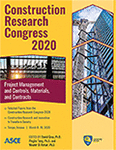Construction Research Congress 2020
Analytical Roofing Crews’ Work Using Micro Scheduling for Productive Roof Replacement in Southeastern Residential Units
Publication: Construction Research Congress 2020: Project Management and Controls, Materials, and Contracts
ABSTRACT
The roofing construction industry is based on informal communication, craftsman apprenticeship, and skills acquired from routine. This manuscript introduces research on a roof replacement procedure for a typical residential unit in South-East Georgia. This is sought for an understanding of intimacy in effective and adaptive team behavior of the construction roofing crews. The main objective of this study is to apprehend linkages between effective roofing teams and the work they perform adaptability, resilience to changing systems, and team cooperation. The study was executed by documenting the project at a micro level; breaking down the roofing crew into micro-teams, analyzing their natural group, and individual work rhythm. The researchers created an approach on production micro-scheduling, combining a repetitive line-of-balance approach, and a mathematical scheduling method for the sequence of roof replacement work. To evaluate team behavior, the study defines efficiencies in roofing tasks completed by the roofing crew. A micro-level analysis of their work has been completed in order to compute the efficiencies of workers within their micro-crews for the roof replacement project. The analysis involved the research group observing on-site activities of working crews and their work task details throughout the job. Their tasks were further analyzed via on-site video recordings and later through scheduling software to determine performances against a baseline work procedure. Development of network task scheduling for all roof areas on this jobsite illustrated the adaptability of a working crew compared with a formal crew through a baseline work procedure. Findings of crews with a well-organized hierarchy of laborers, support, and leadership within their micro-crews display optimum performance in change resiliency and cooperation; these crews are most efficient in their work due to labor distribution and effective active lag use.
Get full access to this article
View all available purchase options and get full access to this chapter.
REFERENCES
Ahuja, V., and Thiruvengadam, V. (2004). “Project Scheduling and Monitoring: Current Research Status.” Construction Innovation: Information, Process, Management4.1: 19-31.
Arashpour, M., Wakefield, R., Blismas, N., and Lee, E. W. M. (2014). “Analysis of disruptions caused by construction field rework on productivity in residential projects.” Journal of Construction Engineering and Management, 140(2), 04013053-1-04013053-12.
Arditi, D., Onur, B. T., and Kangsuk, S. (2001). “Scheduling system for repetitive unit construction using line-of-balance technology.” Engineering Construction and Architectural Management 8.2: 90-103.
Cheng, E., Love, E. P., Irani, Z., and Li, H. (2002). “A model for supporting inter-organizational relations in the supply chain.” Engineering Construction and Architectural Management9.1: 2-15.
Choi, S.D. (2007). “Opportunities for Improving Productivity in Roofing Construction.” International Journal of Construction Research3.1: 67-77.
Faturechi, R., and Miller-Hooks, E. (2014). “A mathematical framework for quantifying and optimizing protective actions for civil infrastructure systems.” Computer-Aided Civil and Infrastructure Engineering Vol. 29: 572–589.
Lee, Lin, Seto, and Migliaccio. (2017). “Wearable sensors for monitoring on-duty and off-duty worker physiological status and activities in construction”. Automation in Construction. 83: 341-53.
Lines, B., Sullivan, K., and Smithwick, J. (2014). “An action research approach to implementation of alternative project delivery methods within architectural, engineering, and construction owner organizations: overcoming resistance through education” Construction Research Congress 2014: 2084-2095.
Lucko, G. (2008). “Productivity scheduling method compared to linear and repetitive project scheduling methods.” Journal of Construction Engineering and Management 134.9: 711-720.
Ranasinghe, U., Ruwanpura, J., and Liu, X. (2012). “Streamlining the construction productivity improvement process with the proposed role of a construction productivity improvement officer.” Journal of Construction Engineering and Management 138.6: 697-706.
Sandbhor, S. S., and Botre, R.P. (2014). “Applying total interpretive structural modeling to study factors affecting construction labour productivity.”Journal of Construction Economics and Building 14.1.
Information & Authors
Information
Published In
Construction Research Congress 2020: Project Management and Controls, Materials, and Contracts
Pages: 701 - 710
Editors: David Grau, Ph.D., Arizona State University, Pingbo Tang, Ph.D., Arizona State University, and Mounir El Asmar, Ph.D., Arizona State University
ISBN (Online): 978-0-7844-8288-9
Copyright
© 2020 American Society of Civil Engineers.
History
Published online: Nov 9, 2020
Published in print: Nov 9, 2020
Authors
Metrics & Citations
Metrics
Citations
Download citation
If you have the appropriate software installed, you can download article citation data to the citation manager of your choice. Simply select your manager software from the list below and click Download.
